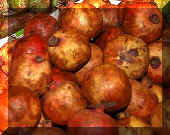 Pomegranates
Native to semi-tropical Asia. Known in Biblical times
Pomegranates
Native to semi-tropical Asia. Known in Biblical times
As with many ancient fruits, there were many beliefs
about its medical value. Mohammed is said once to have told his
followers, "eat the pomegranate, for it purges the system of envy and
hatred." In China and India the Pomegranates and their seeds
symbolize fertility.
Pomegranates are about the size of an apple, but with
hard, inedible rind that is symmetrical but not round. The fruit consists
of many seeds, surrounded by a bright crimson coating that is edible,
pulpy and tart.
Pomegranates are eaten fresh, and the pulp is made into
jellies and grenadine syrup which is used as a flavoring in cocktails,
preserves and baking (grenadine is also made from red currants). When
eaten raw, discard the seeds eating only the pulp surrounding them. Halve
and serve with a spoon. The juice may be frozen into a sherbet; halve and
squeeze as for oranges.
Yield 1 pomegranate = 1 serving
3
pomegranates = about 1 pound
4 pomegranates = 1 cup of juice
Nutrition: 1 pomegranate = about 100 calories





















































